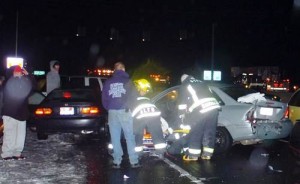Unless you were a home-schooled only child, chances are you’ll recall the daily battle to conform to peer pressure during your high school years. A new study says that teens are not only more likely to try to conform with friends when it comes to music and clothing but also how they drive.
And for a group a new study dubs “thrill seekers,” that significantly raises the chance of getting into a crash, according to a study jointly carried out by insurance giant State Farm and the Children’s Hospital of Philadelphia.
A second new study of 677 young motorists found that more than 70% of male teens involved in serious crashes were distracted by their passengers before the accident occurred. The same was the case with nearly half the female teens. That may put pressure on more states to adopt rules limiting the number of young drivers in a car when the person behind the wheel has just recently been licensed.
The second study, also by State Farm and the Children’s Hospital, found that when they had passengers in the car, teen boys where twice as likely to drive aggressively when there were passengers in the car – and a full six times more likely to speed or perform some other illegal maneuver.
“Most teens take driving seriously and act responsibly behind the wheel,” said study author Jessica Mirman, of the Center for Injury Research and Prevention. “However, some may not realize how passengers can directly affect their driving. Teen passengers can intentionally and unintentionally encourage unsafe driving. Because it can be difficult for new drivers to navigate the rules of the road and manage passengers, it’s best to keep the number of passengers to a minimum for the first year.”
In the first of the two studies, author Allison Curry, also of the Injury Research institute, talked to 198 teens and found some interesting similarities between those that fell into the “thrill seeker” category. For one thing, they were more likely to drive around with friends, even in states where graduated licensing rules might prohibit that.
They also reported that their parents were less likely to set rules or monitor their whereabouts. But perhaps most worrisome, those young motorists were also the ones least likely to understand the risks inherent in driving.
“The good news is that that these teens make up the minority,” said Mirman in the news release. “Teens in this study generally reported strong perceptions of the risks of driving, low frequencies of driving with multiple passengers and strong beliefs that their parents monitored their behavior and set rules.”

